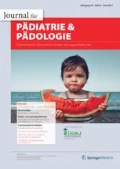Zusammenfassung
Der Übergang vom Adoleszenten- zum jungen Erwachsenenalter ist ein länger dauernder Prozess, der – wie die Pubertät – auch chronologisch und kulturell individuell abläuft. Für diese Übergangsperiode wird etwa ein Zeitraum zwischen dem 18. und 25. Lebensjahr angenommen, in dem verschiedene Entwicklungsaufgaben bewältigt werden müssen: zunehmende, auch wirtschaftliche und juristische Selbstständigkeit und Selbstverantwortlichkeit, ein Übergang von Gruppen- zu individueller Orientierung, das Aufnehmen stabilerer Paarbeziehungen, ein Auseinandersetzen mit dem Selbstbild und den Aufgaben des Erwachsenseins, zunehmende Übernahme von Verantwortung auch für andere sowie das Verlassen der Ursprungsfamilie. Aus medizinischer Sicht sind Selbstständigkeit, Selbstverantwortlichkeit und Entscheidungsfähigkeit wesentliche Faktoren eines Paradigmenwechsels (z. B. Behandlungsvertrag). Dieser Paradigmenwechsel ist zwar legistisch auf einen Stichtag (z. B. den 18. Geburtstag) festgelegt, findet aber in den postmodernen Industriegesellschaften weder im Selbstverständnis noch im realen Prozessfortschritt seine Entsprechung.
Abstract
The transition from adolescence to young adulthood is a long process, which – like puberty – proceeds in chronologically and culturally different ways in each individual. For these transition phases, a period between the ages of 18 and 25 is estimated, during which various developmental milestones should be overcome: increasing financial and legal independence and self-responsibility, transitioning from group to individual orientation, starting more stable personal relationships, coming to terms with self-image and the obligations of adulthood, increasing the transfer of responsibility for others, and leaving the family unit. From a medical point of view, independence, self-responsibility, and decision-making are significant factors of a paradigm shift (e.g. a medical treatment contract). Although this paradigm shift is fixed to an appointed day legally (e.g., the 18th birthday), in postmodern industrial societies this correlates neither with self-image nor with the real process of progress.
Literatur
Arbeitsmarkt Service Arbeitsmarktdaten Österreich. http://www.ams.at/ueber-ams/medien/arbeitsmarktdaten/berichte-auswertungen
Arnett JJ (2010) Adolescence and emerging adulthood. Prentice Hall, Boston
Buyukdemirci K Sexperience-1000. http://www.forbes.com/pictures/femh45kil/sexperience-1000/
Caflisch M (2015) Comment suivre l’adolescent/e dans son parcours de vie en santé sexuelle? https://www.sante-sexuelle.ch/wp-content/uploads/2015/12/M_Caflisch_291015.pdf. Zugegriffen: 21. Mai 2016
Craik FIM, Bialystok E (2006) Cognition through the lifespan: mechanisms of change. Trends Cogn Sci 10(3):131–138
Dosenbach NUF, Nardos B, Cohen AL, Fair DA, Power JD, Church JA, Nelson SM, Wig GS, Vogel AC, Lessov-Schlaggar N, Barnes KA, Dubis JW, Feczko E, Coalson RS, Pruett JR, Barch DM, Petersen SE, Schlaggar BL (2010) Prediction of individual brain maturity using fMRI. Science 329:1358–1361
Feinberg I (1982) Schizophrenia: caused by a fault in programmed synaptic elimination during adolescence? J Psychiatr Res 17(4):319–334
Galvan A (2014) Neural systems underlying reward and approach behaviors in childhood and adolescence. Curr Top Behav Neurosci 16:167–188
Galvan A (2014) Insights about adolescent behavior, plasticity, and policy from neuroscience research. Neuron 83:262–265
Geier CF (2013) Adolescent cognitive control and reward processing: implications for risk taking and substance use. Horm Behav 64(2):333–342
Kail RV (2010) Human Development: A Life-Span View: A Life-Span View. Cengage Advantage Books, Wadsworth
Lamm C, Benson BE, Guyer AE, Perez-Edgar K, Fox NA, Pine DS, Ernst M (2014) Longitudinal study of striatal activation to reward and loss anticipation from mid-adolescence into late adolescence/early adulthood. Brain Cogn 89:51–60
Mills KL, Goddings AL, Clasen LS, Giedd JN, Blakemore SJ (2014) The developmental mismatch in structural brain maturation during adolescence. Dev Neurosci 36:147–160
Narring F, Tschumper A, Bonivento LI, Jeannin A, Addor A, Bütikofer A, Suris J‑C, Diserens C, Alsaker F, Michaud P‑A (2002) Smash-02: Santé et styles de vie des adolescents agés de 16 á 20 ans en suisse. http://www.iumsp.ch/Publications/pdf/RdS95a_fr.pdf
European Parliament Research Service (2014) Youth employment initiative. http://epthinktank.eu/2014/04/03/youth-employment-initiative/
Sowell ER (2001) Mapping continued brain growth and gray matter density reduction in dorsal frontal cortex: inverse relationships during postadolescent brain maturation. J Neurosci 21:8819–8829
Spear LP (2000) The adolescent brain and age-related behavioral manifestations. Neurosci Biobehav Rev 24:417–463
Spear LP (2010) The biology of adolescence. https://www.nationalacademies.org/hmd/~/media/Files/Activity%20Files/Children/AdolescenceWS/Commissioned%20Papers/spear_paper.pdf. Zugegriffen: 21. Mai 2016
Statistik Austria Bildungsniveau der Bevölkerung. https://www.statistik.at/web_de/statistiken/menschen_und_gesellschaft/soziales/gender-statistik/bildung/index.html
Steinberg L, Bornstein MH, Vandell DL, Rook KS (Hrsg) (2011) Lifespan development. Infancy through adulthood. Cengage Learning, Wadsworth
Taylor SJ (2015) The longitudinal development of social and executive functions in late adolescence and early adulthood. Front Behav Neurosci 15(9):252
US Census Bureau http://www.census.gov/hhes/socdemo/marriage/
Villringer A, Pleger B (2010) Plasticity of the human brain. We never use the same brain twice. Report. Leipzig: Max Planck Institute for Human Brain and Cognitive Sciences
Weusthoff A (2013) Frau geht vor. Eigenständige Existenzsicherung von Frauen. In allen Lebenslagen unverzichtbar. https://www.dgb-bestellservice.de/besys_dgb/pdf/DGB40549.pdf
Xue W, Bowman FD, Pileggi AV, Mayer AR (2015) A multimodal approach for determining brain networks by jointly modeling functional and structural connectivity. Front Comput Neurosci 20(9):22
Author information
Authors and Affiliations
Corresponding author
Ethics declarations
Interessenkonflikt
C. Popow gibt an, dass kein Interessenkonflikt besteht.
Dieser Beitrag beinhaltet keine von den Autoren durchgeführten Studien an Menschen oder Tieren.
Rights and permissions
About this article
Cite this article
Popow, C. Was unterscheidet Jugendliche von jungen Erwachsenen?. Paediatr. Paedolog. Austria 51 (Suppl 1), 5–9 (2016). https://doi.org/10.1007/s00608-016-0369-5
Published:
Issue Date:
DOI: https://doi.org/10.1007/s00608-016-0369-5

